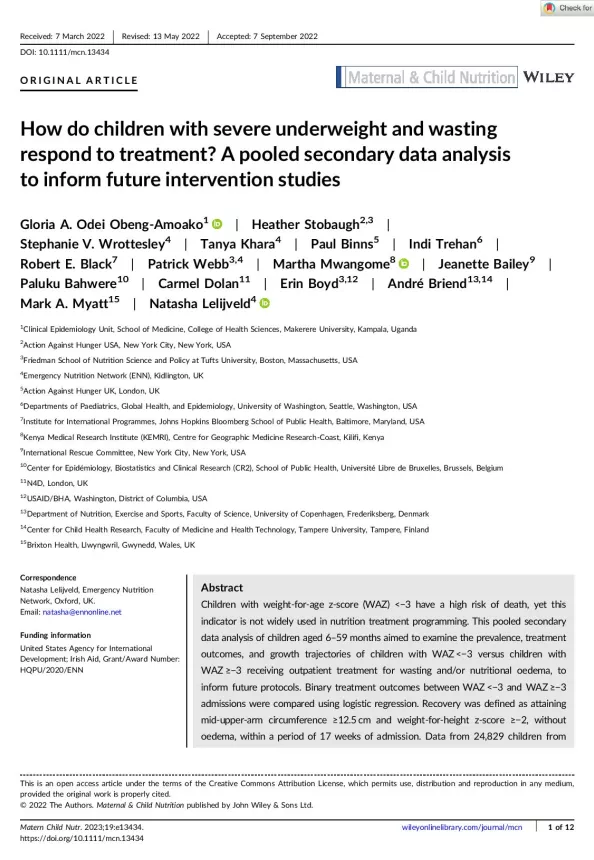How do children with severe underweight and wasting respond to treatment? A pooled secondary data analysis to inform future intervention studies
Publication details
Abstract
Children with weight-for-age z-score (WAZ) <−3 have a high risk of death, yet this indicator is not widely used in nutrition treatment programming. This pooled secondary data analysis of children aged 6–59 months aimed to examine the prevalence, treatment outcomes, and growth trajectories of children with WAZ <−3 versus children with WAZ ≥−3 receiving outpatient treatment for wasting and/or nutritional oedema, to inform future protocols. Binary treatment outcomes between WAZ <−3 and WAZ ≥−3 admissions were compared using logistic regression. Recovery was defined as attaining mid-upper-arm circumference ≥12.5 cm and weight-for-height z-score ≥−2, without oedema, within a period of 17 weeks of admission. Data from 24,829 children from 9 countries drawn from 13 datasets were included. 55% of wasted children had WAZ <−3. Children admitted with WAZ <−3 compared to those with WAZ ≥−3 had lower recovery rates (28.3% vs. 48.7%), higher risk of death (1.8% vs. 0.7%), and higher risk of transfer to inpatient care (6.2% vs. 3.8%). Growth trajectories showed that children with WAZ <−3 had markedly lower anthropometry at the start and end of care, however, their patterns of anthropometric gains were very similar to those with WAZ ≥−3. If moderately wasted children with WAZ <−3 were treated in therapeutic programmes alongside severely wasted children, we estimate caseloads would increase by 32%. Our findings suggest that wasted children with WAZ <−3 are an especially vulnerable group and those with moderate wasting and WAZ <−3 likely require a higher intensity of nutritional support than is currently recommended. Longer or improved treatment may be necessary, and the timeline and definition of recovery likely need review.
Key messages
- Children with WAZ <−3 have a high risk of death, yet this indicator is not widely used in nutrition treatment programming.
- WAZ <−3 is common among both severely and moderately wasted children (64% and 43%, respectively), and those with WAZ <−3 do not meet conventional definitions of nutritional recovery as often as other wasted children. While they do gain weight in a similar pattern as other wasted children, they have further to catch up.
- Children with wasting and WAZ <−3 likely require longer or more tailored treatment, especially children with both moderate wasting and WAZ <−3, who are usually not eligible for therapeutic feeding.
- An intervention trial is needed to further explore these hypotheses and must include non-wasted children with WAZ <−3, who are currently not represented in this secondary data.
